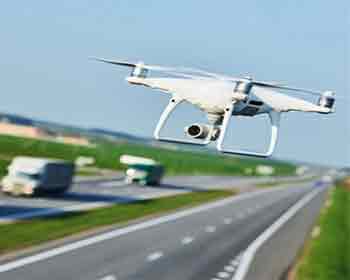Research Outlines Approaches for Profitable Deployment of Cargo Drones
Posted: Aug 24, 2023
 Research at North Dakota State University outlines how technology like data mining, machine learning, and geographic information systems can be used by early cargo drone adopters to identify the most profitable products, origins and destinations, and potential routes for initiating service.
Research at North Dakota State University outlines how technology like data mining, machine learning, and geographic information systems can be used by early cargo drone adopters to identify the most profitable products, origins and destinations, and potential routes for initiating service.
Raj Bridgelall, a researcher with NDSU's Upper Great Plains Transportation Institute, recently authored two journal articles outlining methods and workflow for using the technology to plan key cargo drone deployments. "Data-Driven Deployment of Cargo Drones: A U.S. Case Study Identifying Key Markets and Routes" was published in the journal Algorithms.
The research outlined in Bridgelall's paper established a three-stage data mining and geographic information system workflow that identified four commodity categories and eight metropolitan statistical areas (MSAs) that could yield the highest initial demand for air transport, thereby optimizing logistics operations. The workflow and algorithms revealed that transport within the current 400-mile cargo drone range capability accounted for 80.5% of the truckload equivalents of the four selected commodity categories transported among the eight MSAs.
A second paper, "Unlocking Drone Potential in the Pharma Supply Chain: A Hybrid Machine Learning and GIS Approach," outlined how machine learning and geographic information systems can be used to identify the fewest locations where providers can initiate cargo drone services for a single commodity to yield the greatest initial benefits. The article was published in the journal Standards. The paper focused on pharmaceutical transport because of its relatively low weight and high value.
In the paper, Bridgelall says, "The results show that by starting a service in only nine metropolitan areas across four regions of the contiguous United States, drones with a robust 400-mile range can initially move more than 28% of the weight of all pharmaceuticals. The medical community, supply chain managers, and policymakers worldwide can use this workflow to make data-driven decisions about where to access the largest opportunities for pharmaceutical transport by drones. The proposed approach can inform policies and standards such as Advanced Air Mobility to help address supply chain disruptions, reduce transportation costs, and improve healthcare outcomes."
Bridgelall is director of UGPTI's Center for Surface Mobility Applications & Real-time Simulation environments (SMARTSe) and is an associate professor of transportation and logistics at NDSU.